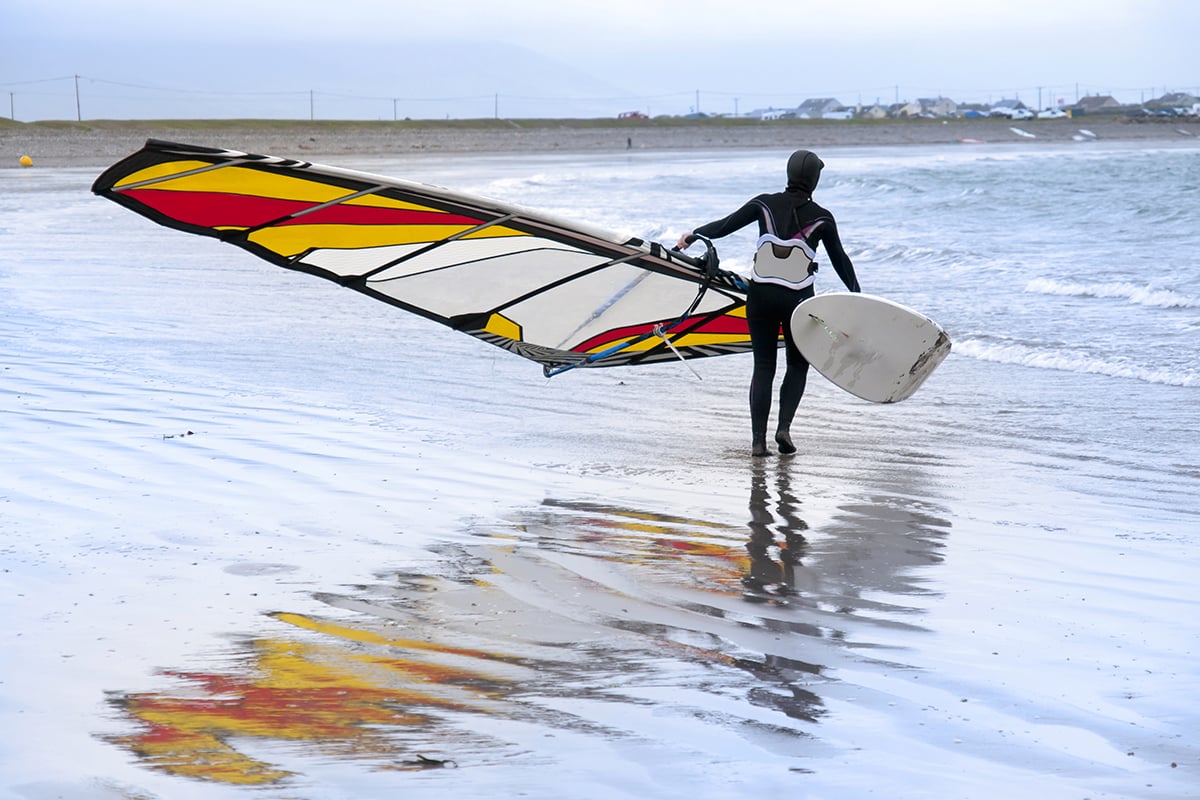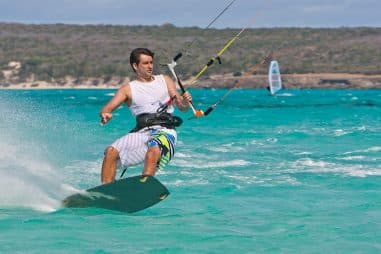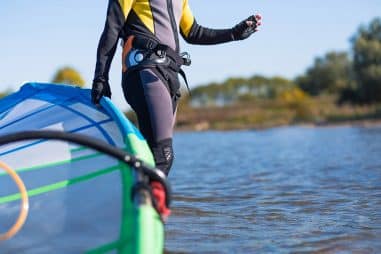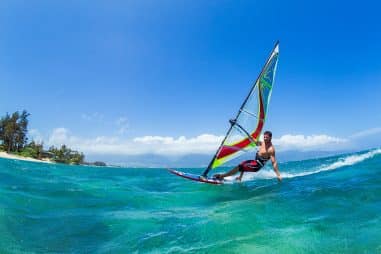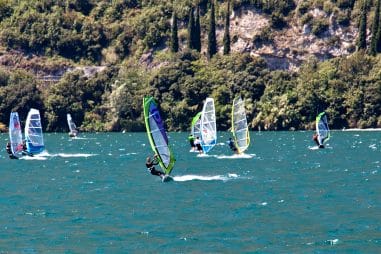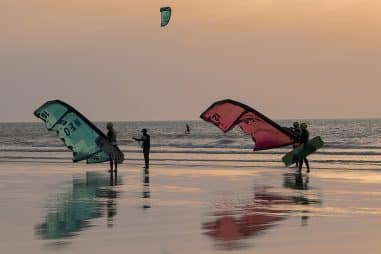Windsurfing is a highly physical sport that combines the fundamentals of other water activities including surfing, wakeboarding, and sailing, to name a few. Over the year, the sport has had an increasing following from thrill-seekers all over the world. If you want to get the deets on what you need to start the sport and how much it costs, then read on.
What Do I Need to Windsurf?
Unlike other water activities and board sports, which only need minimal equipment, you would need to invest in more equipment for windsurfing. Most of this equipment is required for windsurfing itself, while others are necessary for your protection.
Here is a list of the essential gear that you would need for windsurfing:
- The windsurfing board
- The sail
- The mast and mast base
- The uphaul rope
- The universal joint
- The rig
- The boom
- Helmet
- Wetsuit
- Buoyancy Aids
- Aqua shoes or water booties
- Rescue coat or lifejacket
- Sunglasses
How Expensive Is Windsurfing?
Whether you just want to try windsurfing for a few hours or get serious about the sport, windsurfing can be pretty costly. Even if you are only planning to enroll in, say, two days of beginner lessons with all the equipment included, it would still cost you a few hundred dollars.
It will be a lot more expensive if you want to be serious about pursuing the sport. You would need to enroll in a longer beginner course that would allow you to learn the basics thoroughly. Aside from that, you would need to invest in quality gear to make sure that you are 100 percent safe while windsurfing.
What Do You Wear for Windsurfing?
There are a lot of options with regard to your windsurfing attire. However, you have to make sure that you wear them in the right locations and right weather.
- Wetsuit: This is the most common attire used in windsurfing. Wetsuits are designed to keep you warm while also protecting you against injuries. Ease of movement is also one of the most important design concepts that go into the making of wetsuits. You should always take into account your windsurfing location of choice because wetsuits are made with varying thickness. For beginners, a wetsuit that is 2.5 to 3 millimeters is okay. If you happen to be windsurfing in the tropics, you can pick a wetsuit that is thinner. Conversely, you should get thicker wetsuits if you like windsurfing during the cold months.
- Rashguard: This is another popular option for windsurfing. A well-made rash guard will protect you from both the coldness of the water and the heat from the sun. You can pair this with the next one.
- Board shorts: This is usually the bottom of choice for windsurfers. Some board shorts are even waterproof, so you won’t be cold even if you get splashed by the waves. If you want to try windsurfing in board shorts, pick those that are secured with a string and try not to buy those with Velcro straps. Stringed ones are more secure, especially if you get wiped out by the waves.
- Bathing suits: If you happen to be in the tropics and the waves are not too big, you can opt to don a bathing suit. They offer ease of movement, and they are a great choice if you don’t mind getting wet or getting a little sunburned. If you want, you can always wear a t-shirt or a rash guard on top of your swimming tops.
- Water shoes, aqua shoes, water booties: While you are allowed to ride your windsurfer barefoot, it is still recommended to wear water shoes, especially if you are windsurfing during the cold months. Shoes will protect your feet from the cold and from any possibility of injury, bruises, or scratches that you might suffer from the ocean.
At the end of the day, one of the beauties of windsurfing is that it is not restrictive in the clothes department. You can enjoy the sport wearing whatever you want, but it is always recommended to never, ever forget to wear your sunscreen!
How Do I Choose Windsurfing Equipment?
Are you buying your first set of gear or do you want more advanced equipment? Either way, there are many different decisions that you should make and many considerations to think of before choosing your windsurfing gear.
Your beginner set should include the following:
- A board with a soft deck, a volume of 180 to 200 liters, and a retractable daggerboard
- A square sail that is at least 5 meters long
- An aluminum boom that can be extended from 150 to 160 centimeters to 200 to 210 centimeters
- Harness lines that can either be adjustable or fixed
- A standard diameter mast (SDM) extension that is at least 30 to 45 centimeters
- An uphaul line that will help you recover your sail from the water
- A wetsuit (preferably made of neoprene) that can protect you in both cold and warm climate
- Harness
- Life jacket
While you can buy secondhand gear, it is always better to make sure that they are still in good condition before you go ahead with the purchase. If you want to take the sport seriously, you should invest in quality gear.
If you are still unsure what equipment to buy, you can always visit a shop specializing in windsurfing gear to get recommendations from their staff. You should remember that windsurfing is a highly physical sport. While you can be well-trained, there can still be a risk of injury if you buy substandard gear.
How Do I Buy Windsurfing Equipment?
Whether brand new, secondhand, or rental, there are a lot of ways on how you can get your hands on windsurfing equipment. There are a lot of websites and online stores that sell windsurfing gear. They offer amazing deals and easy shopping.
If you happen to live in or nearby a windsurfing tourist spot, chances are there are a lot of sporting goods stores that offer many different types of windsurfing equipment. A pro in visiting an actual store before purchasing your gear is that you get to talk and get recommendations from people who know their windsurfing gear.
How Much Does Windsurfing Gear Cost?
Windsurfing equipment can be pretty expensive. Remember that, unlike other sports, say surfing which only needs the minimum number of gears, windsurfing requires a lot more. Purchasing beginner windsurfing gear by parts can cost you upwards of 3,000 dollars.
There is a complete set of board and rig that sells at around 800 dollars, but you would still need to purchase protective gear, including a helmet, wetsuit, and water shoes.
How Long Is a Windsurfing Board?
Windsurfing boards are made in varying lengths. This is because they cater to riders of different weight and skill levels. For instance, the length of beginner boards can be anything between 285 to 333 centimeters.
On the other hand, intermediate boards should be in the 261 to the 290-centimeter range. Remember that the length caters to a specific weight which means you, a beginner weighing 60 kilograms, should not purchase a windsurfing board that is less or more than 292 centimeters.
Here is a table of the rider’s weight and the appropriate length of a windsurf board to get the complete picture.
Beginner Windsurf Board
| Rider Weight (in kilogram) |
Rider Weight (in pound) |
Length of Windsurf Board (in centimeter) |
| 50 | 110 | 285 |
| 60 | 132 | 292 |
| 70 | 154 | 299 |
| 80 | 176 | 306 |
| 90 | 198 | 313 |
| 100 | 220.5 | 319 |
| 110 | 243 | 326 |
| 120 | 265 | 333 |
Intermediate Windsurf Board
| Rider Weight (in kilogram) |
Rider Weight (in pound) |
Length of Windsurf Board (in centimeter) |
| 50 | 110 | 261 |
| 60 | 132 | 265 |
| 70 | 154 | 269 |
| 80 | 176 | 273 |
| 90 | 198 | 278 |
| 100 | 220.5 | 182 |
| 110 | 243 | 286 |
| 120 | 265 | 290 |
How Much Does a Windsurf Board Weigh?
Windsurf boards are also made in varying weights. This is because they cater to people of different weights and skill levels, and the weight of the board can affect your performance.
A heavy board is often designed to have more volume. It can also successfully go against heavy wind. However, it would be hard to perform planing on this board.
On the other hand, lighter boards are easier to maneuver than heavy boards. They are also great for windsurfing in light winds. Light boards are generally more portable, easier to use and support better performance.
How Do You Size a Windsurf Board?
Windsurf boards are often sized by their volume in liters and not in feet, inches, or centimeters. Boards with high volume are great because they offer stability and flotation. They are also best used when windsurfing in locations with light wind conditions.
You should choose the volume of the board in relation to your riding style, wind conditions, and skill level. Windsurf boards are not created so that one-fits-all, you should be able to find one that is best suited to your needs.
How Do I Choose the Right Size Windsurf Board?
To help in choosing the size of the windsurf board that best fits you, the Royal Yachting Association or RYA came up with a formula:
The sum of your body weight (in kg) and the weight of rig, board, and clothing (which is calculated to be around 30 kg) multiplied by 2 is equal to the volume of the board (in liters).
If you are not sure about your computations, you can always visit your local windsurfing store to ask for expert recommendations.
What Size Windsurfing Board Should I Get?
The rule of thumb in getting the right volume of windsurfing board for when you want to sail in light wind is 1 pound of your weight = 1 liter. So, if you are 160 pounds, then it is best to purchase a board with a volume of 160 liters.
You should also remember that the volume of your board depends on your skill level. If you are a beginner, get a board that is over 170 liters. If you are an intermediate windsurfer, boards between 120 to 160 liters are best suited for you. Finally, if you are an advance rider, purchase a board that is less than 110 liters.
To help you better in choosing the best volume of a windsurf board in relation to your weight, check out the table below.
Beginner Windsurf Board
| Rider Weight (in kilogram) |
Rider Weight (in pound) |
Volume of Windsurfing Board (in liter) |
| 50 | 110 | 145 |
| 60 | 132 | 160 |
| 70 | 154 | 175 |
| 80 | 176 | 190 |
| 90 | 198 | 205 |
| 100 | 220.5 | 220 |
| 110 | 243 | 235 |
| 120 | 265 | 250 |
Intermediate Windsurf Board
| Rider Weight (in kilogram) |
Rider Weight (in pound) |
Volume of Windsurfing Board (in liter) |
| 50 | 110 | 95 |
| 60 | 132 | 108 |
| 70 | 154 | 121 |
| 80 | 176 | 134 |
| 90 | 198 | 147 |
| 100 | 220.5 | 160 |
| 110 | 243 | 173 |
| 120 | 265 | 186 |
How Much Does a Windsurfing Board Cost?
The prices of windsurfing board you can buy across different channels and platforms (internet, your local windsurfing store, sports good stores, among others) vary. The brand and specifications of the board make a big difference in its price.
Generally, boards are often a little pricey. You can get a decent beginner board for more or less 800 dollars in online stores like eBay or Amazon. However, they may not carry all the windsurfing brands.
You can check out the websites of windsurfing brands and order your board directly from them. However, since they are known manufacturers and their products are of excellent quality, prepare to shell out upwards of 1,000 dollars for a new board.
What Is the Best Windsurfing Board?
Whether you are on the lookout for your new favorite windsurfing board or you are just simply looking around and comparing prices, there are a lot of good quality windsurfing boards to choose from.
To help you decide, here is a short list of the top windsurfing boards in the market today.
- Z-Ray Inflatable SUP Windsurfing Board: Made with Polyvinyl chloride or more commonly known as PVC, this board weighs 30.86 pounds and can carry a rider weighing 264 pounds. It is 120 inches in length, 30 inches in width, and 6 inches in thickness when completely inflated. The Z-Ray board is very portable and is best suited for touring and vacation trips due to its make, but you have to make sure that you bring a pump with you to fully maximize this amazing board. This board is excellent for beginners since it offers stability and overall great performance. It is also easy to maneuver, and they work best on flat water or bodies of water with small waves. You can bring and use the Z-Ray board anywhere because it is dent-proof and highly scratch-resistant.
- BIC Sports Ace-Tec Techno Windsurfing Board: This board is made with ACE-TEC Epoxy, and it comes in different volumes, including 225D, 185D, and 160D. The Ace-Tec Techno windsurfing board is very rigid and extremely lightweight, and it supports all skill levels. 185D and 225D are best for both beginners and riders on the heavier side because they have more volume and they are more stable. The 160D board is excellent for both lightweight riders (windsurfing in moderate winds) and big riders riding in high wind. The Ace-Tec board is designed to have a firm deck, and it comes with padded foot straps for the security and safety of the rider. Since the board comes in three sizes, the sizes have different specifications. 160D is 8’3” in length and 32.38 inches in width, weighs 24.25 pounds and is 160 liters in volume. The 185D is 9’7” in length and 31.1 inches in width, weighs 26 pounds, and is 185 liters in volume. Finally, 225D is 9’9” in length and 36.25 inches in width, weighs 41 pounds and is 225 liters in volume.
- 2020 Kona One Windsurfing Board: Made with ASA/EVA construction, this board weighs 34 pounds and can carry a rider weighing 242.5 pounds. It is 138 inches in length and 27.56 inches in width. This board is known for its versatility and maneuverability that even beginners can handle. It is also very stable, which helps beginners in getting up and staying on the board for a longer period of time. The 2020 Kona One board supports different windsurfing styles and goals, and riding conditions. It is great for carving, sub-planning, riding in flat water, and even in high speed rides. This board also comes with paddles made with fiberglass, a 15-inches fin, and a fin box.
- BIC Sport Techno 293 DTT One Design Windsurfing Board: Made with epoxy, the Sport Techno 293 DTT Windsurfing board weighs 27.5 pounds, and it can carry riders weighing 240 pounds. It is 115 inches in length and 32 inches in width. This board is great to have if you are into professional windsurfing racing or leisure riding. This board is very lightweight, which adds to its amazing speed. Aside from that, it has a rigid construction, and it is very easy to maneuver. It is designed with thick paddings for your feet and foot straps for your security and safety.
- Aqua Marina Bt-S300 Inflatable SUP Windsurfing Board: This board is both made with PVC (overall material) and EVA (for the deck). It weighs 36.8 pounds and can accommodate riders weighing 260 pounds. It is 117 inches in length, 30 inches in width, and has a thickness of 6 inches. The Aqua Marina Bt-S300 windsurfing board is highly durable due to the materials used in construction. It is also designed with EVA foam on the deck for maximum comfort and grip and foot straps for your safety. This board is great for riders of all skill levels. Aside from its many desirable specifications, when you buy the Aqua Marina board, it comes with a sail, a pump, a bungee cord, a mast, and a backpack to store them all together.
Are Inflatable Windsurf Boards Any Good?
Inflatable windsurfing boards are an amazing option if you are looking for a new board. They are highly durable, and you don’t need to worry about nose damage. Inflatable windsurf boards have high volume, which makes them more stable.
Aside from that, inflatable windsurf boards are very portable. It doesn’t take too much space on your luggage, you can store it anywhere, and you can quickly inflate it using your pump any time and anywhere.
To add to the many amazing things that inflatable windsurf boards are, they are also a lot cheaper than your regular windsurfing hard boards. You can get your hands on an inflatable board for half the price of a hardboard.
How Do I Choose a Windsurf Board?
There are several things to consider when getting a windsurf board. Some personal and rider considerations include your weight, your riding goal, your riding style, and your skill level.
Aside from that, there are also external factors to consider, such as the riding conditions, type of the board, size of the board, the weight of the board, the construction, features, and the sails that you intend to use.
If you are a beginner, you might want to consider a modern windsurfing board known as retractable daggerboards. They are great if you are just starting out because they offer more stability and greater lateral resistance. Aside from that, the board helps you to stay upright when windsurfing in light wind.
What Are Windsurfing Sails Made of?
There are three materials that are often used in the manufacturing of windsurfing sails. These materials include dacron, mylar, and monofilm.
Dacron is most commonly used for beginner windsurfing sails. This is because the material is very lightweight. However, one con of dacron is that it can stretch out of shape.
The second material is mylar and is dacron in a coated form. Compared to dacron, it holds its shape better. However, it may delaminate over time.
The third material is monofilm, and it is the newest out of the three. Out of the three, it holds its shape best. It is also clear, which allows for good visibility. Due to its popularity, more manufacturers opt to use this material in their sails.
How Much Does a Windsurf Sail Weigh?
Windsurf sails are designed with varying weights. The weights also vary depending on the material used and the battens. Since dacron is much lighter than mylar and monofilm, sails made of dacron are a lot lighter.
If you are sailing in a location with gusty wind conditions, it is best to use a sail that holds its shape, albeit a little heavier. Lighter windsurfing sails are more suitable for activities like down the live wave sailing.
What Size Windsurfing Sail Do I Need?
On average, a sail that is in the range of 5.5 to 6.3 meters or 18 to 20 feet is great to have. A sail of this size can be easily controlled by beginners. However, they are only more suitable for winds that are up to forces four or five.
If the wind gets stronger, it would be better to use smaller sails in the range of 4 to 5 meters or 13 to 15 feet. Smaller sails are easier to control, especially if you are up against increasingly strong winds.
Windsurfing sails are made in varying sizes, as small as 3 meters or approximately 9 feet to as large as 10 meters or 32 feet, because they all cater to different wind conditions, skill levels, and riding styles.
For instance, a 3-meter windsurfing sail is best used by experienced wave sailors who want to sail in gale force wind conditions. On the other hand, the bigger sails are more suitable for competitive windsurfers whose goal is to sail as fast as possible in very light winds.
Other factors that you should consider when choosing the size of your windsurf sail include the wind speed and speed that you intend to sail. To get a clearer picture of this, we prepared a table demonstrating this alongside the sail size.
| Sail Size (in square meter/m2) |
Speed (in kilometer per hour/kph) |
Wind (in knots/kts) |
| 3.0 | 60 | 2 |
| 3.6 | 49 | 27 |
| 4.8 | 37 | 20 |
| 5.8 | 31 | 17 |
| 7.8 | 23 | 13 |
| 10.4 | 17 | 9 |
| 12.5 | 14 | 8 |
If you are still on the fence on which one to get, you can always consult windsurfing experts in windsurfing stores near you.
How Do I Choose a Sail for Windsurfing?
There are several factors that you should take into consideration when buying your windsurfing sail. Because the sail has to be strong enough to power through strong winds, it needs to be elastic, strong, and durable.
Aside from that, your sail has to be resistant to stretching (which results in the sails being out of shape), and they have to be lightweight. These two factors are very important because sails with these characteristics perform better overall, and they are more unsusceptible to damage, which means you would incur fewer repair costs.
Aside from these characteristics, you should also choose a sail that will work best with your body weight and the wind speed of your location of choice.
Here is a table showing the right size of sail (in square meters or m2) to use depending on the weight of the rider and the speed of the wind.
| Weight of Rider (kg) | Wind Speed (knots) | |||||||||
| 5 | 7 | 10 | 13 | 15 | 20 | 25 | 30 | 35 | 40 | |
| 50 | 12.5m2 | 10.4 m2 | 6.4 m2 | 5.8 m2 | 4.8 m2 | 3.6 m2 | 3.0 m2 | 3.0 m2 | 3.0 m2 | 3.0 m2 |
| 55 | 12.5 m2 | 11.4 m2 | 7.1 m2 | 5.8 m2 | 4.8 m2 | 3.6 m2 | 3.3 m2 | 3.0 m2 | 3.0 m2 | 3.0 m2 |
| 60 | 12.5 m2 | 11.4 m2 | 7.8 m2 | 6.4 m2 | 5.3 m2 | 4.0 m2 | 3.6 m2 | 3.0 m2 | 3.0 m2 | 3.0 m2 |
| 65 | 12.5 m2 | 12.5 m2 | 8.6 m2 | 7.1 m2 | 5.8 m2 | 4.4 m2 | 3.6 m2 | 3.0 m2 | 3.0 m2 | 3.0 m2 |
| 770 | 12.5 m2 | 12.5 m2 | 9.4 m2 | 7.1 m2 | 6.4 m2 | 4.8 m2 | 4.0 m2 | 3.0 m2 | 3.0 m2 | 3.0 m2 |
| 75 | 12.5 m2 | 12.5 m2 | 10.4 m2 | 7.8 m2 | 6.4 m2 | 4.8 m2 | 4.0 m2 | 3.3 m2 | 3.0 m2 | 3.0 m2 |
| 80 | 12.5 m2 | 12.5 m2 | 10.4 m2 | 8.6 m2 | 7.1 m2 | 5.3 m2 | 4.4 m2 | 3.6 m2 | 3.3 m2 | 3.0 m2 |
| 85 | 12.5 m2 | 12.5 m2 | 11.4 m2 | 8.6 m2 | 7.8 m2 | 5.3 m2 | 4.4 m2 | 3.6 m2 | 3.3 m2 | 3.0 m2 |
| 90 | 12.5 m2 | 12.5 m2 | 12.5 m2 | 9.4 m2 | 7.8 m2 | 5.8 m2 | 4.8 m2 | 4.0 m2 | 3.6 m2 | 3.0 m2 |
| 95 | 12.5 m2 | 12.5 m2 | 12.5 m2 | 9.4 m2 | 8.6 m2 | 6.4 m2 | 5.3 m2 | 4.4 m2 | 3.6 m2 | 3.3 m2 |
| 100 | 12.5 m2 | 12.5 m2 | 12.5 m2 | 10.4 m2 | 9.4 m2 | 6.4 m2 | 5.3 m2 | 4.4 m2 | 4.0 m2 | 3.3 m2 |
| 105 | 12.5 m2 | 12.5 m2 | 12.5 m2 | 11.4 m2 | 9.4 m2 | 7.1 m2 | 5.8 m2 | 4.8 m2 | 4.0 m2 | 3.6 m2 |
| 110 | 12.5 m2 | 12.5 m2 | 12.5 m2 | 11.4 m2 | 10.4 m2 | 7.1 m2 | 5.8 m2 | 4.8 m2 | 4.4 m2 | 3.6 m2 |
| 115 | 12.5 m2 | 12.5 m2 | 12.5 m2 | 12.5 m2 | 11.4 m2 | 7.8 m2 | 6.4 m2 | 5.3 m2 | 4.4 m2 | 3.6 m2 |
| 120 | 12.5 m2 | 12.5 m2 | 12.5 m2 | 12.5 m2 | 11.4 m2 | 7.8 m2 | 6.4 m2 | 5.3 m2 | 4.4 m2 | 4.0 m2 |
How Long Is a Windsurfer Mast?
On average, windsurfer masts are designed to be 460 centimeters or 15.1 feet. The windsurf mast is an important part of the windsurf sail because it serves as the spine and support of the sail. They are inserted into the mast sleeve or the leading edge of the sail.
It is important to select the best mast for your sail so that it would perform at its optimum capacity. You may already own the best sail, but if you partner it with the wrong mast, it could deform the sail and throw everything into chaos.
There are different components of a mast that you should consider if you are thinking of buying one. These include composition, carbon content, stiffness, bend curve, and thickness. You should also pay attention to your weight and the wind speed of the locality, as these would also affect your choice of a mast.
What Is IMCS in Windsurfing?
The Indexed Mast Check System, also known as IMCS, indicates the stiffness of the mast. The mast is given an IMCS value, and it indicates how much it bends under a load. The IMCS value is calculated using this formula:
IMCS = (Length in cm /Mid Point Deflection in cm) x 216225
Some pointers to remember if you are still undecided if you should get a stiffer or softer mast, the stiffer mast has the following characteristics:If the mast has a lower IMCS, that means that it is softer or more flexible. Conversely, if the mast has higher IMCS, it is stiffer.
- It is overall better for heavier riders.
- It is suitable for sailing in flat water.
- It has a fuller profile.
- It has more power.
On the other hand, the softer mast is known to have these characteristics, which include:
- It is more suitable for light riders.
- It has a flatter profile.
- It has less power.
- It has a softer feel.
- It adds control.
How Do I Choose a Windsurfer?
If you are a beginner or an intermediate rider looking for a windsurfer, you should always bear in mind that your weight and skill level should factor in your decision. A windsurfer that is perfect for your buddy may not be perfect for you and vice versa.
Windsurfers are not created to fit all kinds of riders. Both the sail and the board are created in varying sizes and weights because they cater to different types of riders.
What Windsurfer Should I Buy?
The good news is, whether you are a beginner or a windsurfing fanatic looking for your first or new favorite windsurfer, there are a lot of manufacturing companies that cater to your different needs.
While some only build and sell a specific part of windsurfs, there are some companies that make an extensive range of surfing equipment. Some of these companies include JP Australia, KA Sails, Loftsails, Gaastra, North, Fanatic, Severne, and Niel Pryde.
Here are some of the world’s most beloved windsurfing brands that you can check out if you are on the lookout for a new board, sail, or fins.
| Windsurfing Boards | Windsurfing Sails | Windsurfing Fins | Windsurfing Accessories |
| WitchCraft | Tushingham | Vector Fins | Powerex |
| AHD | Aerotech | Black Project Fins | Dakine |
| Tiga | Severne | True Ames Fins | No Limitz |
| AirInside | Avanti | Choco Fins | Aeron |
| Thommen1 | Point 7 | Tectonics Maui | K3 |
| Angulo | Blade | Curtis Fins | Prolimit |
| Tabou | North Sails | Techart Fins | Mystic |
| Bic | Challenger | Deboichet Custom | |
| Starboard | Neil Pryde | Smart Fins | |
| Drops | Chinook | Fasfins | |
| RRD | Naish | Select Fins | |
| Exocet | Ezzy | Gsport Precision Fins | |
| Quatro | Maui Sails | Rainbow Fins | |
| F2 | Gaastra | Maui Ultra Fins | |
| Naish | Loft | MFC Hawaii | |
| Fanatic | HiTech | ||
| Mistral | Lefebvre | ||
| Goya | Hot Sails Maui | ||
| Lorch | KA Sail | ||
| Gun | Insect | ||
| Kona | |||
| HTS Boarder Division | |||
| JP Australia |
If you are still not sure what to purchase, you can always visit the windsurfing store near you for expert advice and recommendation.
How Much Does a Windsurfer Cost?
If you buy windsurfing gear per part, it can set you back more than 3,000 dollars. This is based on the retail prices of windsurfing gear posted on Amazon. Here is a line item cost of the gear you can purchase online to give you a clearer picture of how much each gear can cost you.
| Gear | Price |
| Board and fin | $1,700 |
| Sail | $700 |
| Mast and mast base | $364 |
| Boom | $195 |
| Extension | $55 |
| Harness and Harness Lines | $222 |
| Wetsuit (2-3 millimeter) | $125 |
| Water Shoes | $26 |
| Uphaul | $20 |
| TOTAL | $3407 |
You can probably save if you opt to buy secondhand gear but always remember to choose quality products, whether brand new or secondhand. You should never be stingy, especially if it is your safety on the line.
How Much Does It Cost in Total to Start Windsurfing?
If the gear can make a massive dent in your wallet, more or less a 3,407-dollar dent in particular, then you should know by now that getting into the sport is not a small feat, budget-wise. Gear, lessons and travel costs altogether can cost you upwards of 5,000 dollars.
Beginners have to take lessons, and the price of these lessons vary from location to location, season to season, and package to package. For instance, some windsurfing schools in Australia offer a group session for 8 hours that is around 250 dollars. In Europe, a one-hour introductory lesson can cost you 40 euros.
Aside from the lessons, beginners need to rent their first windsurfing kit. Depending on the location, the board and sail can cost you anything between 15 to 36 dollars. And the rental fee would be on an hourly basis and not for the whole day.
It is understandable that the sport will not be as expensive for advanced riders because 1) they already own gears, and 2) they have no need for instructors. But the sport can still incur costs. Of these expenses, the biggest chunk would be the travel cost.
If you want to try windsurfing in other places, you can either choose to bring along your gear or rent them when you get to the location. Bringing them along would mean you would have to pay for check-in baggage.
If you are planning to get new gear, you can opt to sell your old ones. However, you have to understand that the value of these gear depreciates, and, at best, you can sell them 20 to 30 percent of what you originally bought them for.
Aside from those points, remember that these gears are only good for a few years as they also go through wear and tear. If you use them often, that would mean that you may have to replace the gear sooner than later.
While windsurfing can be hard for the budget, people find the sport to be very fulfilling. Many enthusiasts would say that the sport is worth every penny.

